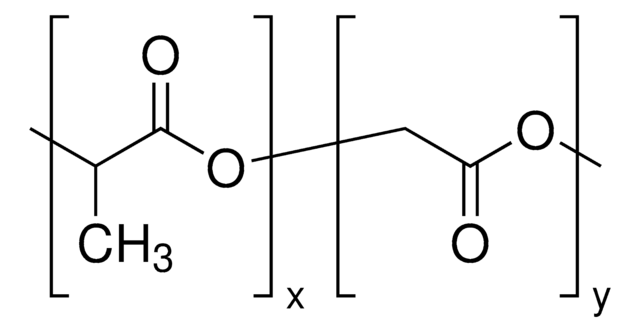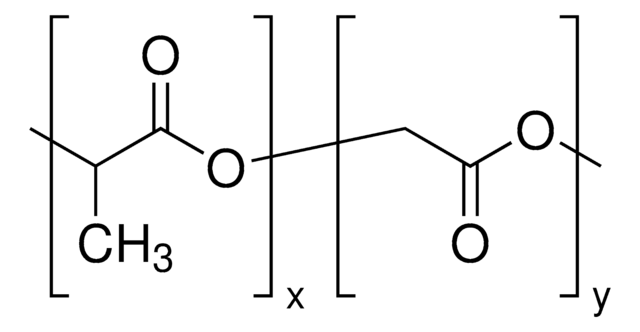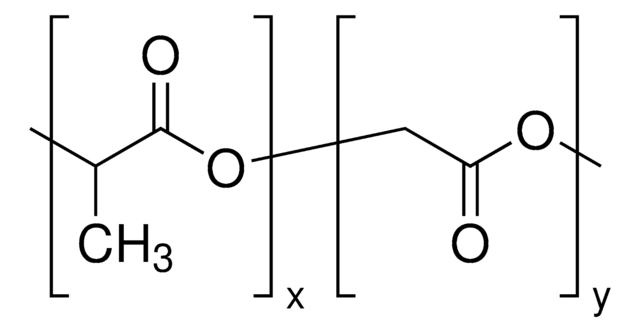Product 430471 has a dodecyl (12 carbon) ester on one end of the polymer chain and a hydroxyl end group on the other.
430471
Poly(D,L-lactide-co-glycolide)
ester terminated, Mw 50,000-75,000
Sinónimos:
Lactel® B6006-1, PLGA
Seleccione un Tamaño
68,20 €
Seleccione un Tamaño
About This Item
68,20 €
Productos recomendados
Nivel de calidad
Formulario
amorphous
cociente alimentación
lactide:glycolide 85:15
mol peso
Mw 50,000-75,000
marco temporal de la degradación
<6 months
viscosidad
0.55-0.75 dL/g, 0.1 % (w/v) in chloroform(25 °C)
temperatura de transición
Tg 45-50 °C
solubilidad
ethyl acetate, chloroform, acetone and THF: soluble
temp. de almacenamiento
2-8°C
cadena SMILES
OCC(O)=O.CC(O)C(O)=O
InChI
1S/C3H6O3.C2H4O3/c1-2(4)3(5)6;3-1-2(4)5/h2,4H,1H3,(H,5,6);3H,1H2,(H,4,5)
Clave InChI
XBBVURRQGJPTHH-UHFFFAOYSA-N
¿Está buscando productos similares? Visita Guía de comparación de productos
Descripción general
Aplicación
Características y beneficios
Forma física
Información legal
Código de clase de almacenamiento
11 - Combustible Solids
Clase de riesgo para el agua (WGK)
WGK 3
Punto de inflamabilidad (°F)
Not applicable
Punto de inflamabilidad (°C)
Not applicable
Equipo de protección personal
Eyeshields, Gloves, type N95 (US)
Elija entre una de las versiones más recientes:
¿Ya tiene este producto?
Encuentre la documentación para los productos que ha comprado recientemente en la Biblioteca de documentos.
Los clientes también vieron
Artículos
Interest in utilizing biodegradable polymers for biomedical applications has grown since the 1960s.
Synthetic aliphatic polyesters dominate resorbable biomaterials in clinical use.
AliAliphatic polyesters, including polylactide and polyglycolide, are biodegradable polymers widely used in medical applications.
Immunosuppressive tumor-associated myeloid cells (TAMC) are responsible for glioblastoma (GBM) resistance to immunotherapies and existing standard of care treatments. This mini-review highlights recent progress in implementing nanotechnology in advancing TAMC-targeted therapies for GBM.
-
What are the end groups of Product No. 430471 (Poly(DL-lactide-co-glycolide)?
1 respuesta-
¿Le ha resultado útil?
-
-
What is the tensile strength of Product No. 403471 Poly(DL-lactide-co-glycolide)?
1 respuesta-
Product 430471 has a tensile strength of 6000 - 8000 psi, with an elongation of 3-10%.
¿Le ha resultado útil?
-
-
What is the Department of Transportation shipping information for this product?
1 respuesta-
Transportation information can be found in Section 14 of the product's (M)SDS.To access the shipping information for this material, use the link on the product detail page for the product.
¿Le ha resultado útil?
-
-
What is the density of Product No. 430471 Poly(DL-lactide-co-glycolide)?
1 respuesta-
According to the manufacturer, product 430471 has a theoretical density of 1.27g/mL.
¿Le ha resultado útil?
-
-
Is Product No. 403471 a resorbable polymer?
1 respuesta-
Yes, Product No. 430471 has a resorption time of 5-6 months.
¿Le ha resultado útil?
-
-
How is this Product No. 430471 synthesized (Poly(DL-lactide-co-glycolide)?
1 respuesta-
To synthesize product 430471, 1-dodecanol is used as an initiator and stannous octoate is used as a catalyst to start the ring opening polymerization of D,L-lactide and glycolide monomers.
¿Le ha resultado útil?
-
Filtros activos
Nuestro equipo de científicos tiene experiencia en todas las áreas de investigación: Ciencias de la vida, Ciencia de los materiales, Síntesis química, Cromatografía, Analítica y muchas otras.
Póngase en contacto con el Servicio técnico




